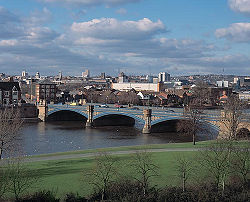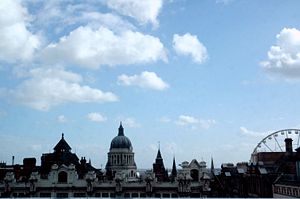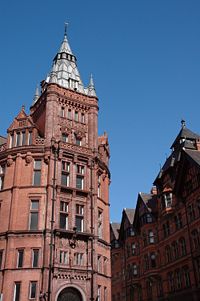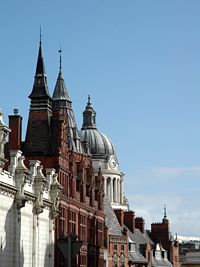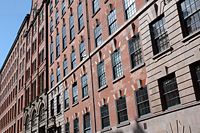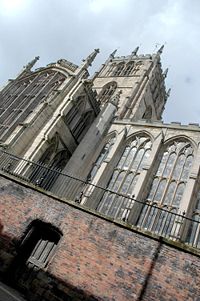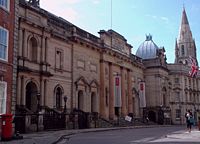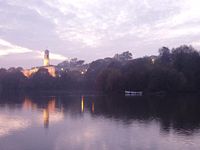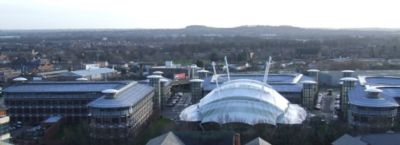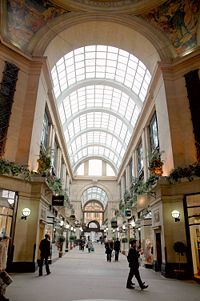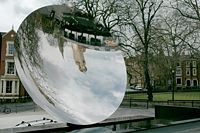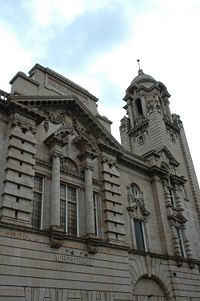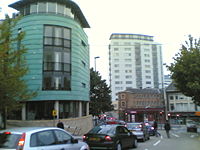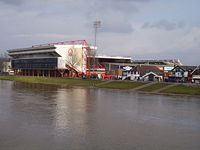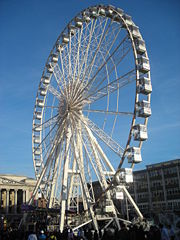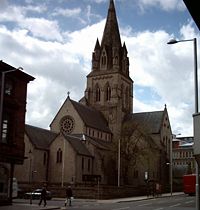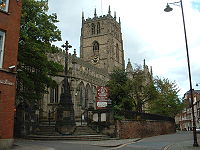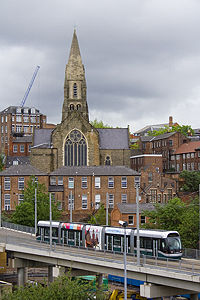Nottingham
2008/9 Schools Wikipedia Selection. Related subjects: British Cities; Great Britain
| City of Nottingham | |||
| Nottingham and the River Trent seen from the bank of West Bridgford. | |||
|
|||
| Coordinates: | |||
|---|---|---|---|
| Sovereign state | United Kingdom | ||
| Constituent country | England | ||
| Region | East Midlands | ||
| Ceremonial county | Nottinghamshire | ||
| Admin HQ | Nottingham City Centre | ||
| Settled | AD 600 | ||
| City Status | 1897 | ||
| Government | |||
| - Type | Unitary authority, City | ||
| - Governing body | Nottingham City Council | ||
| - Leadership | Leader & Cabinet | ||
| Area | |||
| - City | 28.8 sq mi (74.61 km²) | ||
| Population (2006 est.) | |||
| - City | 286,400 | ||
| - Density | 9,673.6/sq mi (3,735/km²) | ||
| - Urban | 666,358 | ||
| - Ethnicity (2005 Estimate) |
82.1% White 7.4% S. Asian 4.7% Black British 3.2% Mixed Race 2.6% Chinese and other |
||
| Time zone | Greenwich Mean Time ( UTC+0) | ||
| Twin Cities | |||
| - |
Belgium (since 1985) | ||
| - |
Zimbabwe (since 1981) | ||
| - |
Germany (since 1969) | ||
| - |
Slovenia (since 1963) | ||
| - |
Belarus (since 1966) | ||
| - |
China (since 2004) | ||
| Grid Ref. | SK570400 | ||
| ONS code | 00FY | ||
| ISO 3166-2 | GB-NGM | ||
| NUTS 3 | UKF14 | ||
| Website: www.nottinghamcity.gov.uk/ | |||
Nottingham ( /ˈnɒtɪŋəm/ ) is a city in the ceremonial county of Nottinghamshire, England. Its conurbation is the largest in the East Midlands region of England.
In 2006 Nottingham had a city population of 286,400. However, Nottingham City's border is tightly drawn and so this figure excludes many places which most people consider to be Nottingham, such as Carlton, Gedling and West Bridgford. The Greater Nottingham conurbation, which does include these areas along with the large expanse of suburbs and towns on the outskirts such as Ilkeston, Long Eaton and Eastwood, has a population of 666,358. It is the 7th largest urban area in the United Kingdom, ranking between Liverpool and Sheffield. Nottingham is also a member of the English Core Cities Group.
At the heart of Nottingham City Centre is the Old Market Square. This 22,000 sq/m open space is the largest square in England and was refurbished in 2007 to include a large water feature, which consists of numerous fountains and gushing rapids. The entire square was also re-surfaced with granite slabs and new trees planted. The reaction to the redevelopment was mixed. Nottingham Council House which overlooks the square can be seen for miles around thanks to its 200 ft (61 m) high dome which rises above the city and is lit up at night. Inside the Council House is the Exchange Arcade, an upmarket shopping centre which houses many high class shops, shopping being one of the main attractions of the City. Radiating out from the central square are the other areas of the city. The Hockley quarter, characterised by a higher proportion of independent retailers and alternative cinema, is situated to the east of the city. Hockley is adjacent to the Lace Market area which is home to many large grand Victorian era buildings owing to Nottingham's importance in the Victorian Lace Industry, the City's history being another main attraction. The Lace Market now has numerous bars and restaurants. To the south of the square shopping streets lead their way into the soon to be totally rebuilt Broadmarsh shopping centre. Beyond the shopping centre lies the canal which is a pleasant area full of cafes and restaurants. To the west is Nottingham Castle and Maid Marian Way which is home to The Tales of Robin Hood along with the majority of the high rise office buildings in the city. Northwards from the square is the Victoria Shopping Centre, numerous restaurants and a cinema complex. The Theatre Royal, Nottingham on Theatre Square and Nottingham Playhouse at the Albert Hall can also be found here.
History
Nottingham is relatively unusual among major manufacturing cities in Britain in having a mediæval and pre-industrial past of equal importance to its more recent one. The first evidence of settlement dates from pre- Roman times, and it is possible that the Romans also lived in the area.
In Anglo-Saxon times, around 600 AD, the site formed part of the Kingdom of Mercia, when it was known in the Brythonic language as "Tig Guocobauc" meaning "a place of cave dwellings", until falling under the rule of a Saxon chieftain named Snot, whereby it was dubbed "Snotingaham" literally, "the homestead of Snot's people" (Inga = the people of; Ham = homestead). Snot brought together his people in an area where the historic Lace Market in the City can now be found.
Nottingham was captured in 867 by Danish Vikings and later became one of the Five Burghs - or fortified towns - of The Danelaw.
In the 11th century, Nottingham Castle was constructed on a sandstone outcrop by the River Leen. The Anglo-Saxon settlement developed into the English Borough of Nottingham and housed a Town Hall and Law Courts. A settlement also developed around the castle on the hill opposite and was the French borough supporting the Normans in the castle. Eventually, the space between was built on as the town grew and the Old Market Square became the focus of Nottingham several centuries later.
| Year | Population |
|---|---|
| 4th century | <37 |
| 10th century | <1000 |
| 11th century | 1,500 |
| 14th century | 3,000 |
| early 17th century | 4,000 |
| late 17th century | 5,000 |
| 1801 | 29,000 |
| 1811 | 34,000 |
| 1821 | 40,000 |
| 1831 | 51,000 |
| 1841 | 53,000 |
| 1851 | 58,000 |
| 1861 | 76,000 |
| 1871 | 87,000 |
| 1881 | 159,000 |
| 1901 | 240,000 |
| 1911 | 260,000 |
| 1921 | 269,000 |
| 1931 | 265,000 |
| 1951 | 306,000 |
| 1961 | 312,000 |
| 1971 | 301,000 |
| 1981 | 278,000 |
| 1991 | 273,000 |
| 2001 | 275,000 |
| 2006 | 286,400 |
| source: localhistories.org | |
In the 15th century, Nottingham had established itself as the centre of a thriving export trade in religious sculpture made from alabaster. The town became a county corporate in 1449, giving it effective self-government, in the words of the charter, "for eternity". The Castle and Shire Hall were expressly excluded and technically remained as detached Parishes of Nottinghamshire.
During the Industrial Revolution, much of Nottingham's prosperity was founded on the textile industry; in particular, Nottingham was an internationally important centre of lace manufacture. However, the rapid and poorly planned growth left Nottingham with the reputation of having the worst slums in the British Empire outside India. Residents of these slums rioted in 1831, in protest against the Duke of Newcastle's opposition to the Reform Act 1832, setting fire his residence, Nottingham Castle.
In common with the UK textile industry as a whole, Nottingham's textile sector fell into headlong decline in the decades following World War II, as British manufacturers proved unable to compete on price or volume with the output of factories in the Far East and South Asia. Very little textile manufacture now takes place in Nottingham, but the City's heyday in this sector endowed it with some fine industrial buildings in the Lace Market district. Many of these have been restored and put to new uses.
Nottingham was one of the boroughs reformed by the Municipal Corporations Act 1835, and at that time consisted of the parishes of Nottingham St Mary, Nottingham St Nicholas and Nottingham St Peter. It was expanded in 1877 by adding the parishes of Basford, Brewhouse Yard, Bulwell, Radford, Sneinton, Standard Hill and parts of the parishes of West Bridgford, Carlton, Wilford ( North Wilford). In 1889 Nottingham became a county borough under the Local Government Act 1888. City status was awarded as part of the Diamond Jubilee celebrations of Queen Victoria, being signified in a letter from the Prime Minister the Marquess of Salisbury to the Mayor, dated 18 June 1897. Nottingham was extended in 1933 by adding Bilborough and Wollaton, parts of the parishes of Bestwood Park and Colwick, and a recently developed part of the Beeston Urban District. A further boundary extension was granted in 1951 when Clifton and Wilford (south of the River Trent) were incorporated into the city.
Architecture
Nottingham has some truly magnificent architecture, buildings from a vast swathe of history stretching right back to the 1100s have been built in the City. Victorian Nottingham saw a building boom with many grand buildings being built owing to the City's 19th century importance. Architects such as Alfred Waterhouse, Thomas Chambers Hine and Watson Fothergill have all built spectacular buildings in Nottingham.
The western third of the city is home to most of the modern offices and businesses of the city, several tall office buildings line Maid Marian Way whilst there are some handsome buildings around Oxford and Regent Streets mainly occupied by professional firms. The Albert Hall was rebuilt in 1909 after the original Watson Fothergill masterpiece burnt down, sits next to the comparatively unimpressive Nottingham Cathedral by Pugin. Nottingham Castle and its grounds are located further south in the western third of the city. The central third descends from the University district in the north, past the Arkwright Building which is a beautiful example of gothic revival architecture and was previously Nottingham's public library - Nottingham Trent University now owns this building as well as many in the area. Theatre Royal on Theatre Square with its pillared facade was built in 1865 in just six months. Head further south down King and Queen Street which are home to many magnificent Victorian architecture buildings designed by the likes of Alfred Waterhouse who designed London's Natural History Museum and Nottingham's own Watson Fothergill whose buildings are distinctive and unique.
The central focal point of the City is Old Market Square which is the largest in the UK and is home to many beautiful buildings, most notably Nottingham Council House. This was built in the 1920s to display civic pride, ostentatiously using baroque columns and placing stone statues of two lions at the front to stand watch over the square; the Exchange Arcade inside the building contains an upmarket shopping centre with boutique shops, it is a small but beautiful covered area. Portland Stone, the same as used for St Paul's Cathedral, was used to construct the Council House and Exchange Arcade. Streets lead from all directions off the square but to the south, shopping streets lead their way in to the Broadmarsh Shopping Centre which is soon to be completely rebuilt. Plans include a massive three floor centre with glass covered 'streets' (similar to the Birmingham Bullring) a landmark new building on the southwest corner of the site and a new transport terminus for the tram lines and buses.
The Canalside, further south of this is adjacent to the railway station and several new but sympathetically designed modern offices and is an inviting redevelopment of 19th century industrial buildings into a cluster of bars and restaurants. The eastern third of the city contains the Victoria Shopping Centre which was built in the 1970s on the site of the demolished Victoria Railway Station. All that remains of the beautiful old station building is the clocktower and the station hotel which is now the Hilton Hotel, Nottingham. The Victoria Centre flats stand above the shopping centre and run the whole length of it. At 250 feet high they are the tallest buildings in the city. The eastern third also contains perhaps the most interesting areas of the city, such as Hockley Village. ( Photos) Hockley is where the vast majority of the individual shops are to be found. Hockley is also home to two cinemas which show alternative cinema. They are the Broadway cinema and The Screen Room cinema. The Screen Room is the smallest in the world with only 21 seats and was the cinema of choice for Quentin Tarantino's UK premier of Reservoir Dogs. The Lace Market area is another interesting area just south of Hockley. The Lace Market was once the heart of Britain's Lace industry during the 19th century British Empire and the area provides a snapshot of typical Victorian Britain, with its densely packed streets full of 4-7 story red brick warehouses, ornate iron railings and red phone boxes.
These have all been restored and cleaned and the buildings are now used for different purposes, New College Nottingham now has many sites in the Lace Market including the impressive Adams Building built by Thomas Chambers Hine for Thomas Adams. Many of the buildings are also now used for upmarket city centre apartments. Several bars and restaurants also have premises in the Lace Market. The area was once a run down one with the warehouses abandoned but since cleaning and gentrification is now an attractive aspect to this part of the city. The church of St Mary the Virgin is also in this area and is widely considered to be the best example of an English cross-shaped church. On this medieval site was supposedly where Robin Hood was arrested after being betrayed by a monk and subsequently imprisoned by the Sheriff of Nottingham, before being rescued by Little John. It and the adjacent Shire Hall are two interesting buildings from the city's medieval past. The Georgian built Galleries of Justice are also in the Lace Market, they were used as courts and prisons from 1780 for 200 years although the site has been home to a court since 1375.
Wollaton Hall lies about 2.5 miles (4.0 km) to the west of the city centre. This building built in 1588 is a massive piece of spectacular Tudor period architecture, it is home to the city's Natural History Museum and is set in 500 acres (2.0 km²) of deer park taking a large chunk out of the urban area surrounding it. It is located just north of the University of Nottingham's University Park Campus.
Three pubs in Nottingham claim the title of "England's Oldest Pub". The contenders for the title are Ye Olde Trip To Jerusalem near the castle which is partly built into the cave system, The Bell on the Old Market Square, and The Old Salutation on Maid Marian Way. All of which are some of the cities oldest buildings and make for fascinating viewing. Ye Olde Trip To Jerusalem is supposedly named for its role as a meeting point for those going on the Crusades in the Middle Ages. Its claim of the being the oldest is due partly to the questionable date of 1189 painted on the side of the inn. A recent television documentary tested the three claimants and found that, while each has its own evidence, none can claim exclusivity. The Trip, while the oldest building and oldest location, was for most of its early life a brewery and not a public house. The Salutation sits on the oldest recognised public house site, but the current building is comparatively recent. The Bell, although not in such an antiquated location, does boast the oldest public house building. There is also conflicting information available: dendrochronology from roof timbers in the Salutation give a date for the building of c.1420 with similar dates for the Bell. Ultimately, the roots of the multiple claims can be traced to various subtleties of definition in terms such as public house and inn.
Education
Despite a lot of investment, the closing of numerous schools and the opening of new city academies, Nottingham remains near the bottom of the league tables at both primary school and secondary school levels. At primary level, Nottingham was ranked second-worst overall in the country, at 149th out of 150 local authorities rated.
At secondary level, Nottingham came third from bottom nationally in terms of GCSE results attained.
The authority has instituted a plan for wide-sweeping reform of education across the city, but in many cases have been met with opposition from parents who say the planned changes are not in the best interests of education. Stanstead School, in the Rise Park area, successfully managed to prevent its planned closure, with the Independent Schools' Adjudicator finally ruling against the authority in February 2006.
The decision, the first of its kind in the country, adds more weight to the campaigns of the many other schools attempting to prevent closure or amalgamation.
Nottingham is home to two universities: the University of Nottingham and Nottingham Trent University (formerly Trent Polytechnic). Together they are attended by over 40,000 full-time students. The University of Nottingham's teaching hospital, University of Nottingham Medical School, is part of the largest hospital in the UK, the Queen's Medical Centre.
Other notable educational institutions include the further education college New College Nottingham, Confetti Institute of Creative Technologies, Nottingham High School, Bilborough College, Nottingham High School for Girls, The Nottingham Bluecoat School and Technology College, South Nottingham College, The Midlands Academy of Dance and Drama and Djanogly City Academy and Greenwood Dale Technology College. Nottingham is home and headquarters of the National College for School Leadership.
The Nottingham School of Fashion is a fashion school respected around the country. The designer Paul Smith trained there.
Industry
Nottingham is home to the headquarters of many well-known companies. One of the best known is Boots the Chemists, founded in the city by Jesse Boot 1st Lord Trent in 1849 and substantially expanded by his son John Boot (2nd Lord Trent).
Other large current employers include the credit reference agency Experian, the energy company E.ON UK, the tobacco company John Player & Sons, betting company Gala Group, engineering company Siemens, sportswear manufacturers Speedo, high street opticians Vision Express, games and publishing company Games Workshop (creator of the popular Warhammer series), and the American credit card company Capital One, whose European offices are situated by the side of Nottingham station. Nottingham is also the home of HM Revenue and Customs and the Driving Standards Agency.
Although Boots itself is no longer a research-based pharmaceutical company, a combination of former Boots researchers and university spin-off companies have spawned a thriving pharmaceutical/science/biotechnology sector. BioCity, the UK's biggest bioscience innovation and incubation centre, sits in the heart of the city and houses around thirty science-based companies. Other notable companies in the sector include ClinPhone and Pharmaceutical Profiles. The city has recently been made one of the UK's six Science Cities.
Until recently bicycle manufacturing was a major industry, the city being the birthplace of Raleigh Cycles in 1886 and later joined by Sturmey-Archer, the creator of 3-speed hub gears. However, Raleigh's factory on Triumph Road, famous as the location for the filming of Saturday Night and Sunday Morning, was demolished in Summer 2003 to make way for the University of Nottingham's expansion of Jubilee Campus.
Nottingham is also joint headquarters of Paul Smith, the high fashion house.
Creative Industries are a target growth sector for the city with graphic design, interiors and textile design being a particular focus. already many small design companies are establishing a base in the city with Jupiter and the multi-award winning Purple Circle being two of the higher profile consultancies. Nottingham City Council has recently announced that other target sectors include Financial and Business Services, Science and Technology, Public Sector and Retail and Leisure as part of their economic development strategy for the city.
Ceramics manufacturer Mason Cash was founded and continues to have operations in Nottingham.
The schools and aerial photographers, H Tempest Ltd were Nottingham-based for many years, until relocating to St. Ives (Cornwall) around 1960. A skeleton office remained for many years in the original building next to Mundella School.
Many of the UKs railway ticket machines and platform departure boards run software written by Atos Origin in their offices in Nottingham. Other major industries in the city include engineering, textiles, knitwear and electronics. An increasing number of software developers are located in Nottingham: Reuters and Monumental Games are based in the city, with Free Radical Design located in nearby Sandiacre and Serif Europe based between Wilford and Ruddington, south west of the Trent and east of Clifton.
Nottingham is progressively changing from an industrial city to one based largely in the service sector. Tourism—particularly from the United States and the Far East—is becoming an increasingly significant part of the local economy.
In 2004 Nottingham had a GDP per capita of £24,238 (US$48,287, €35,529), which was the highest of any English city after London, and the fourth highest of any city of the UK, after London, Edinburgh and Belfast.
| Year | Regional Gross Value Added (£m) |
Agriculture (£m) |
Industry (£m) |
Services (£m) |
|---|---|---|---|---|
| 1995 | 4,149 | 2 | 1,292 | 2,855 |
| 2000 | 5,048 | 1 | 912 | 4,135 |
| 2003 | 5,796 | - | 967 | 4,828 |
| source: Office for National Statistics | ||||
Shopping
In 2007, Nottingham was positioned fourth in the retail shopping league of England (CACI Retail Footprint 2007), behind London, Birmingham and Manchester, but ahead of Leeds, Liverpool, Southampton, Bluewater and Newcastle.
There are two main shopping centres in Nottingham: Victoria Centre and Westfield Broadmarsh. Work on redeveloping Westfield Broadmarsh at a cost of £400 million (creating 400 stores, 136,000m² of shopping space) is to start in 2008 although this could be offset by closures elsewhere in the city. Debenhams and Marks and Spencer are to be the anchors of the new centre, which will be open in 2011. Smaller shopping centres are the The Exchange Arcade, the Flying Horse Walk (once a famous hotel) and new developments in Trinity Square and The Pod. The new developments will increase the shopping sales area in the city centre by 28% to 4,300,000 square feet (399,000 m²). The Bridlesmith Gate area has numerous designer shops, and is the home of the original Paul Smith boutique. There are also various side streets and alleys that hide some interesting and often overlooked buildings and shops - streets such as Poultry Walk, West End Arcade and Hurts Yard. These are home to many specialist shops as is Derby Road, near the Cathedral and once the antiques area but now home to some the city's most interesting independent shops.
Nottingham has a number of department stores including the House of Fraser, John Lewis, and Debenhams. Hockley Village caters to alternative tastes with shops like Ice Nine and Void, famous across the city.
Culture
Nottingham has two large-capacity theatres, the Nottingham Playhouse and the Theatre Royal (which together with the neighbouring Royal Concert Hall forms the Royal Centre) and a smaller theatre space at the University of Nottingham's Lakeside Arts Centre. There are also several art galleries which often receive national attention, particularly the Nottingham Castle Museum, the Angel Row Gallery (attached to the main library), the University of Nottingham's Djanogly Gallery and Wollaton Park's Yard Gallery. The visual arts in Nottingham will be significantly enhanced in 2008 and 2009 by the opening of New Art Exchange and Centre for Contemporary Art Nottingham. In a new £13.9 million 3000 square metre building on the corner of High Pavement and Middle Hill designed by Caruso St John, CCAN will be one of the largest venues for exhibitions of contemporary art in the UK. Both of the city's universities also put on a wide range of theatre, music and art events open to the public throughout the year.
The city has several multiplex cinemas alongside two arthouse cinemas in Hockley. The independent cinemas are the Broadway Cinema, one of the major independent cinemas in the UK and Screen Room, which claims to be the world's smallest cinema (at just 21 seats). Broadway was redeveloped and expanded in 2006. Quentin Tarantino held the British premiere of Reservoir Dogs there in 1992.
There is a classical music scene, with long-established groups such as the city's Symphony Orchestra, Philharmonic Orchestra, Harmonic Society, Bach Choir, Early Music Group Musica Donum Dei and the Symphonic Wind Orchestra giving regular performances in the city.
The annual Goose Fair in October is always popular, being one of the largest fairs in the country.
Nottingham won the Britain in Bloom competition, in the Large City category, in 1997, 2001, 2003 and 2007. It also won the Entente Florale Gold Award in 1998.
Nottingham is known for its large teenage alternative scene ( rock, punk, emo etc.), the heartland of which is Old Market Square. Another focus for their activities is the Rock City concert venue. The Sumac Centre based in Forest Fields has for many years supported local upcoming musicians, artists and film makers, and a variety of campaign groups.
Nottingham has a strong grass roots "Do it yourself" music culture, and is very in touch with underground trends in modern music. Nottingham is renowned as one of the biggest cities supporting the Dubstep movement of dance music. It also has a strong DIY Punk and Indie/Folk scene based at venues such as The Old Angel Inn, The Rose of England and Lee Rosys Tea in Hockley.
Tourism
Nottingham receives a considerable volume of tourism, with almost 300 thousand people visiting from overseas in 2005 alone. Many visitors are attracted by Nottingham's nightlife and shops, by its history, and by the legend of Robin Hood, visiting Sherwood Forest, Nottingham Castle and The Tales of Robin Hood on Maid Marian Way. Popular history-based tourist attractions in central Nottingham include the Castle, City of Caves, Lace Market, The Galleries of Justice, and the City's ancient pubs.
Parks and gardens include Wollaton Park (over 500 acres) near the University Highfields Park on the University of Nottingham campus, Colwick Park, which includes the racecourse, and the Nottingham Arboretum, Forest Recreation Ground and Victoria Park which are in or close to the city centre. Sherwood Forest, Rufford Country Park, Creswell Crags and Clumber Park are further away from the city itself. A new park is being developed in the city at the Eastside City development.
The Nottingham Robin Hood Society was originally formed by Robin Hood historian Jim Lees and two Nottingham teachers Steve and Ewa Theresa West in 1972. Steve and Ewa Theresa played the part of Maid Marion and Robin Hood and attracted a ' band' of like minded followers who ' costumed up ' nearly every weekend for a function . The then society acted in street theatre, appeared at charity events and functions and for several years ' held up ' the appointed Sheriff of Nottingham at the opening of the annual Nottingham Festival. The society also made a film for Japanese Television and joined in picnics and midnight vigils around in Major Oak to promote tourism. Although a Nottingham Robin Hood Society remains the original society members disbanded after the death of Jim Lees.
Museums and galleries
- Brewhouse Yard Museum, a museum of Nottingham Life
- Centre for Contemporary Art Nottingham - under construction and due to open in 2008.
- The Galleries of Justice - Museum of Law Trust based at the Shire Hall in the Lace Market
- Green's Windmill and Science Centre
- Nottingham Castle Museum and Art Gallery - home to the city’s Decorative Art and Fine Art collections, along with the Story of Nottingham galleries, and the Sherwood Foresters Regimental Museum
- Nottingham Industrial Museum
- Nottingham Museums of Costume and Textiles in Castlegate
- Nottingham Natural History Museum - based at Wollaton Hall.
- Nottingham Transport Heritage Centre in Ruddington is a museum of local transport. It has an eight mile (13 km) long railway where Heritage steam trains and Diesel locomotives are used on passenger runs, a classic Road Transport collection (mostly omnibuses) with many Nottingham assosiated vehicles to see, a miniature and model railway and many other things.
Demographics
Nottingham has significant Black and Asian populations, and is becoming increasingly more mixed as more immigrants arrive from Eastern Europe, the Middle East, and Africa.
Nottingham is also said to have a higher female-to-male ratio though this is disputed. This myth may date back to the heavy casualties suffered by a local pals battalion in the First World War.
Nottingham also has on average over 50,000 full-time students studying across the two universities.
The influence of the ethnic groups can be seen with the widespread influence of Black and Jamaican culture on the different ethnicities in the city. Hyson Green is the most multi-religious and multi-racial part of the city with Radford Road being the hub of activity. Once home to the city's Black and Pakistani communities it is now becoming increasingly Middle Eastern in its makeup.
Entertainment
The 2,500-capacity Nottingham Royal Concert Hall and 9,500-capacity Nottingham Arena attract the biggest names in popular music. For less mainstream acts and a generally more intimate atmosphere, Nottingham has a selection of great smaller venues including Junktion 7, The Old Angel, the award-winning dedicated rock music venue Rock City and Rock City's compact sister venues The Rescue Rooms, The Bodega Social Club and Stealth. These venues, with their packed listings and close proximity, make Nottingham one of the centres of live popular music in the UK.
" Nottingham Playhouse" is the major producing theatre in the city including some new and innovative works.
In the 1980s, Nottingham was barely mentioned in the Good Food Guide; but now there are several restaurant entries and a range of cuisine reflecting the ethnic diversity of the city. The Nottingham Restaurant Awards play a leading role in promoting the industry.
The large number of students in the city bolsters the night time entertainment scene. There are several well established areas of the city centre for entertainment such as Lace Market, Hockley, The Waterfront and The Corner House.
Sport
Nottingham is home to two professional football teams: Nottingham Forest (promoted to the Football League Championship at the end of the 2007-08 season) who under their most famous manager, the late Brian Clough, won the European Cup twice in succession, and Notts County (who play in Football League Two). Notably, these two stadia are the closest in England, divided by the River Trent. The latter is the oldest professional Football League team in the world, having been founded in 1862 - a year before the establishment of the Football Association.
Trent Bridge cricket ground, located across the river in West Bridgford, Rushcliffe, is the home of Nottinghamshire County Cricket Club, who were winners of the 2005 County Championship and runners-up in the 2006 Twenty20 cup competition. Trent Bridge is a major venue for international Test matches, and also hosts other important cricketing events such as the Twenty20 cup finals and regular one-day international games. The ground, which has won architectural awards for the design of some of its newer stands, also houses a cricket academy, a hotel, and a gym, and also uniquely features not one, but two public houses built within the ground itself.
All three famous sports venues are within sight of each other even though the River Trent separates Trent Bridge and Forest's stadium (known as the City Ground and near the cricket ground) from Notts County's ground, Meadow Lane. Meadow Lane is in the City of Nottingham and the City Ground is in the County of Nottingham, the river forming the boundary. Forest should not be confused with 'The Forest', which is an open green space where the Goose Fair (see above) is held; however, the club takes its name from this open space, having been founded there in 1865. This makes Forest the third oldest club in the league.
The National Ice Centre, a large ice skating rink; the city's links to ice skating can be traced back to arguably its most famous children of recent times, Olympic ice dancing champions Jayne Torvill and Christopher Dean who collected a unanimous 6.0 score at the 1984 Winter Olympics at Sarajevo. The NIC is used as a training and competition venue for speed skating, sledge hockey and figure skating and receives an annual grant from bodies such as Sport England to maintain and fund these sports.
The NIC is the home of the Nottingham Panthers ice hockey team, founded in 1946 and the current holders of the Challenge Cup. There is a thriving junior ice hockey programme which is also based at the centre. Since 2001, Nottingham has been the host city of the annual ice hockey Play-Off Championship Finals weekend, which attracts fans from many different parts of the country. Also calling the NIC home is the Nottingham North Stars recreational ice hockey team. Founded in 1989 North Stars are one of the oldest recreational clubs in the country.
The city's rugby union side, Nottingham R.F.C. are currently based at a new venue in West Bridgford near the City Ground, and play their league matches at Meadow Lane.
There is a large tennis centre, where the annual Nottingham Open is held in the weeks immediately prior to Wimbledon and has been used as warm-up practice by various tennis stars.
The National Water Sports Centre is based at Holme Pierrepont, with a 2000 m regatta lake for rowing, canoeing and sailing, and a white water slalom canoe course fed from the river. A number of other sailing, rowing and canoeing clubs are also based along the River Trent, as is the boatbuilder Raymond Sims.
Every year since 1981 Nottingham has played host to the 'Robin Hood Marathon' taking in many of the city's historic and scenic sights. The race is run alongside a half marathon and a fun run among other events and is widely considered to be the second best marathon in the UK.
Motorcycle speedway racing was staged in Nottingham before the Second World War. The original venue known as Olympic Speedway was redeveloped by the building of the White City stadium which also featured speedway. A book by Philip Dalling, published by Tempus Publishing, chronicles speedway events in Nottingham. For a short spell in the 1980s the promotion based at Long Eaton raced under the Nottingham Speedway banner and the team was known as Nottingham Outlaws.
Transport
Road
Nottingham is close to the M1 motorway and major roads the A52 and the A46. To the west of Nottingham through to Derby, the A52 is known as Brian Clough Way.
Air
East Midlands Airport in Leicestershire, served by low-cost international airlines, makes the city easily accessible from other parts of the world providing daily services to many principal European destinations such as Paris, Frankfurt, Berlin, Oslo and Amsterdam, internal flights to Edinburgh and Belfast and limited services to trans-continental destinations such as Barbados, Mexico, Sanford and Florida. Nearby Robin Hood Airport Doncaster Sheffield also provides domestic European and Trans-Atlantic services. Birmingham International airport is about one hour's drive away and 2 hours 15 minutes on the train, providing flights to most principal European cities, New York, Boston, Toronto, Montreal, Dubai and the Indian sub-continent.
Rail
Nottingham is served by rail services operated by East Midlands Mainline from Nottingham railway station to London, CrossCountry and local services by East Midlands Connect.
The re-opening of the Robin Hood Line to passengers rather than just freight, between 1993 and 1998 linked Nottingham with its close neighbours Hucknall, Mansfield, Kirkby-in-Ashfield and Sutton-in-Ashfield. Other lines connect the city to Beeston, Burton Joyce, Netherfield and Carlton. Nottingham has direct services to London, Leeds, Birmingham, Leicester, Lincoln, Manchester, Sheffield, Liverpool and Norwich as well as many other conurbations.
From 11 November 2007 Midland Mainline and Central Trains services in Nottingham were combined into a new franchise, East Midlands Trains, with the exception of the Nottingham to Cardiff services which are now operated by CrossCountry.
Also, from the December 2008 timetable change, Nottingham will be served by an hourly express from Leeds, operated by Northern Rail. This service will serve Nottingham, Chesterfield, Dronfield, Sheffield, Meadowhall, Barnsley, Wakefield Kirkgate and Leeds.
Nottingham railway station is the last survivor of a once much larger rail network around Nottingham. At one time Nottingham was served by four other railway stations,
- Nottingham Victoria Station (closed 1967)
- Nottingham Arkwight Street (Closed 1969)
- Nottingham London Road High Level (closed 1969)
- Nottingham London Road Low Level (closed 1948)
Light rail
Nottingham Express Transit a light rail system opened in 2004, running from Hucknall in the north to the city's railway station. An additional spur to/from Phoenix Park serves as a Park and Ride Station close to the M1 motorway (Junction 26). See National Park and Ride Directory for details. Phase 2 development of the system will add two new lines to the southern suburbs of Wilford and Clifton and western suburbs of Beeston and Chilwell to create a three-line network.
Buses
In 2005 Nottingham was bucking the national trend, as bus use in the city was growing and employment rates were rising. This is a result of the city council, as well as the two principal operators, Nottingham City Transport (NCT) and Trent Barton, making multi-million-pound investments in some of the newest fleets in the country. NCT was also the first transport operator in the UK to use RFID technology for its EasyRider bus passes, introduced in 2000. The two operators are also frequent winners of the National Bus Operator of the Year award. Also new Shoplink services operated by Premiere Travel. Also Veolia (Dunn-Line) operate in Nottingham as well.
Crime
Nottingham is served by Nottinghamshire Police and has a Crown Court and Magistrates' Court.
In 2000 - 2003 the press and other media claimed Nottingham was the 'gun-crime capital of the UK', although by 2007 the BBC reported that the number of shootings in the City had fallen from 51 (in 2003) to 13 (in 2006). In January 2008, however, it was reported that gun crime in the city had risen for a second consecutive year with a 50% increase in gun crime during 2007. The incidence of many crimes in Nottingham is several times higher than the English average. A 2006 crime survey stated that Nottingham topped the crime rankings for police statistics on murders, burglaries, and vehicle crime, and "had almost five times the level of crime as the safest town in the rankings". The survey was condemned as inaccurate by Nottingham City Council and Nottinghamshire Police due largely to the use of out of date (2001) population figures, and The University of Nottingham argued that the way in which statistics such as these are calculated is severely flawed, and if the population of the entire conurbation were taken into account instead of just the centre of the city then a more accurate picture would be revealed. A revised survey based on 2004 population estimates, however, appears to back up the original rankings. In 2007 a property focused TV programme named Nottingham as the 4th worst city to live in, stating the city has "loads of good aspects but crime lets it down". Interestingly the same programme also ranked the neighbouring Nottinghamshire borough of Rushcliffe, which contains suburbs of Greater Nottingham, among the best 20 places to live in the UK.
While the crime figures in the city are high, initiatives introduced to tackle the levels of crime appear to be having an effect, with a 2006 Home Office survey showing that the overall level of crime in the city is down by 12% since 2003. Initiatives include the Community and Neighbourhood Protection Service developed by Nottingham City Council, Nottinghamshire Police and Nottingham City Homes to take an uncompromising stance to anti-social behaviour. It comprises Community Protection Officers (CPOs), Police Officers, Police Community Support Officers (PCSOs) and Anti-Social Behaviour Officers who work with internal and external agencies to reduce anti-social behaviour and the fear of crime.
Community Protection Officers (also known as City Wardens) highly visible in their bright yellow stab vests, are accredited by the Chief Constable of Nottinghamshire Police to issue Fixed Penalty Notices (FPNs) for littering and are employed to tackle other anti-social behaviour.
Religion
In Nottingham one can find places of worship for all the major world religions, including Christianity, Judaism, Islam, Hinduism, Sikhism and Taoism. The Nottingham Inter-faith Council works to make connections between faith groups and show the wider public the importance of spiritual aspects of life and the contribution faith groups make to the community.
The Roman Catholic Cathedral of St. Barnabas on Derby Road was designed by the architect Augustus Welby Northmore Pugin, it was consecrated in 1844 and is the cathedral church for the Roman Catholic Diocese of Nottingham established in 1850 which covers Nottinghamshire (except Bassetlaw District), Leicestershire, Derbyshire (except Chesterfield and parts of the High Peak), Rutland and Lincolnshire (pre-1974 boundaries).
Nottingham has three historic Anglican parish churches all of which date back to mediæval times. St. Mary the Virgin, in the Lace Market, a member of the Greater Churches Group is the oldest foundation (dating from the eighth or ninth centuries) but the building is at least the third on the site dating from 1377 to 1485. St. Mary's is considered the mother church of the city and civic services are held here, including the welcome to the new Lord Mayor of Nottingham each year. St.Peter's in the heart of the city is the oldest building in continuous use in Nottingham, with traces of building starting in 1180. St. Nicholas' was rebuilt after destruction in the Civil War.
Non-conformism was strong from the 17th century onwards and a variety of chapels and meeting rooms proliferated throughout the town. Sadly many of these grand buildings have been demolished, including Halifax Place Chapel, but some have been re-used, notably High Pavement Chapel which is now a public house. The offices of the Congregational Federation are in Nottingham. William Booth, the founder of the Salvation Army, was born in Nottingham in 1829.
Today there are a number of large Christian congregations in Nottingham. These include: The Christian Centre which is a Pentecostal church meeting in the centre of Nottingham; Trent Vineyard who meet in Lenton and is part of the Vineyard churches movement; Cornerstone who meet in Wollaton; Grace Church Nottingham who meet at Notts County Football Ground, and is part of the Newfrontiers family of churches.
Geography
Nottingham is located at (52.9667,-1.1667).
The City of Nottingham boundaries are tightly drawn and exclude several suburbs and satellite towns that are usually considered part of Greater Nottingham, including Arnold, Carlton, West Bridgford, Beeston and Stapleford. Outlying towns and villages include Hucknall, Eastwood, Tollerton, Ruddington, Ilkeston and Long Eaton of which the last two are in Derbyshire. The geographical area of Greater Nottingham includes several local authorities: Gedling, Broxtowe, Rushcliffe, Ashfield, Erewash and Amber Valley.
| Destinations from NOTTINGHAM | |||||||||||
| Sheffield | Arnold, Hucknall, Mansfield |
Gedling, Newark-on-Trent | |||||||||
| University of Nottingham, Beeston, Stapleford, Ilkeston, Wollaton, Derby |
|
Carlton, Grantham | |||||||||
| Long Eaton, Tamworth, Birmingham | West Bridgford, Edwalton, Leicester |
Melton Mowbray, Oakham | |||||||||
| Districts within Nottinghamshire | |
|---|---|
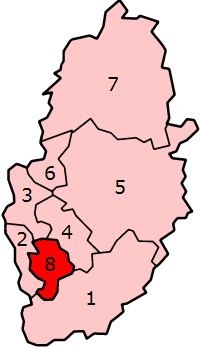 |
|
| 1 | Rushcliffe |
| 2 | Broxtowe |
| 3 | Ashfield |
| 4 | Gedling |
| 5 | Newark and Sherwood |
| 6 | Mansfield |
| 7 | Bassetlaw |
| 8 | Nottingham |
Within the City of Nottingham
- Alexandra Park
- The Arboretum
- Aspley
- Bakersfield
- Beechdale
- Bilborough
- Bulwell
- Basford
- Bestwood Park
- Carrington
- Cinderhill
- Clifton
- Colwick
- Dunkirk
- Forest Fields
- Hockley
- Hyson Green
- Lace Market
- Lenton
- Lenton Abbey
- Mapperley
- Mapperley Park
- The Meadows
- Nottingham City Centre
- The Park
- Radford
- Rise Park
- Sherwood
- Sneinton
- St Anns
- Strelley
- Top Valley
- Whitemoor
- Wilford
- Wollaton
Around the City of Nottingham
- Arnold
- Beeston
- Bingham
- Bulcote
- Burton Joyce
- Carlton
- Chilwell
- Daybrook
- Eastwood
- Edwalton
- Gedling
- Holme Pierrepont
- Hucknall
- Ilkeston (Derbyshire)
- Kimberley
- Kirkby-in-Ashfield
- Long Eaton (Derbyshire)
- Mansfield
- Netherfield
- Nuthall
- Porchester
- Redhill
- Ruddington
- Sandiacre (Derbyshire)
- Stapleford
- Thorneywood
- Toton
- Trowell
- West Bridgford
- Woodthorpe
Twin cities
Nottingham is twinned with the following cities:
 — Ghent, Belgium (since 1985)
— Ghent, Belgium (since 1985) — Harare, Zimbabwe (since 1981)
— Harare, Zimbabwe (since 1981) — Karlsruhe, Germany (since 1969)
— Karlsruhe, Germany (since 1969) — Ljubljana, Slovenia (since 1963)
— Ljubljana, Slovenia (since 1963) — Minsk, Belarus (since 1966)
— Minsk, Belarus (since 1966) — Ningbo, China (since 2004)
— Ningbo, China (since 2004)
The county of Nottinghamshire is twinned with Poznań, Poland.
